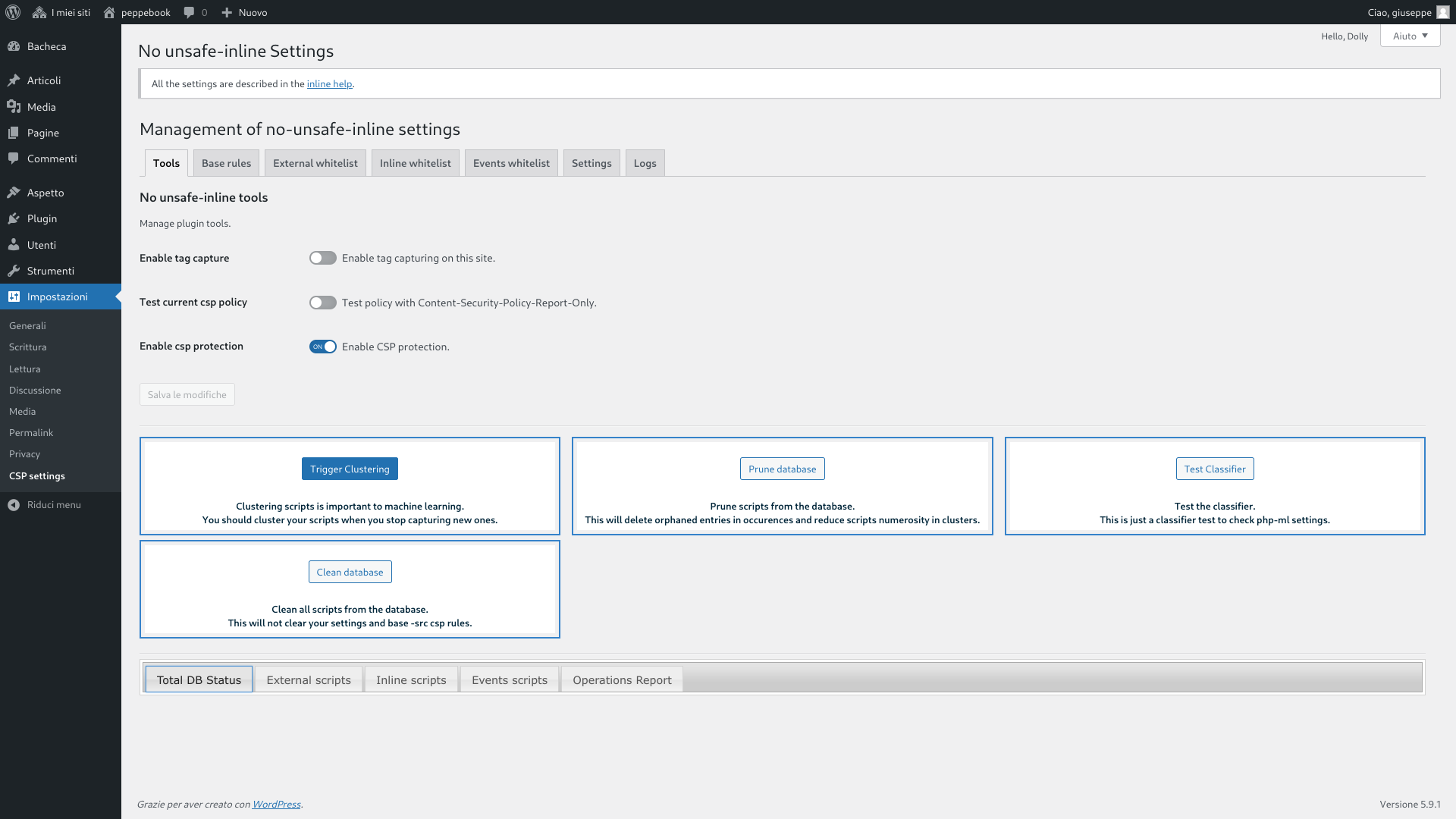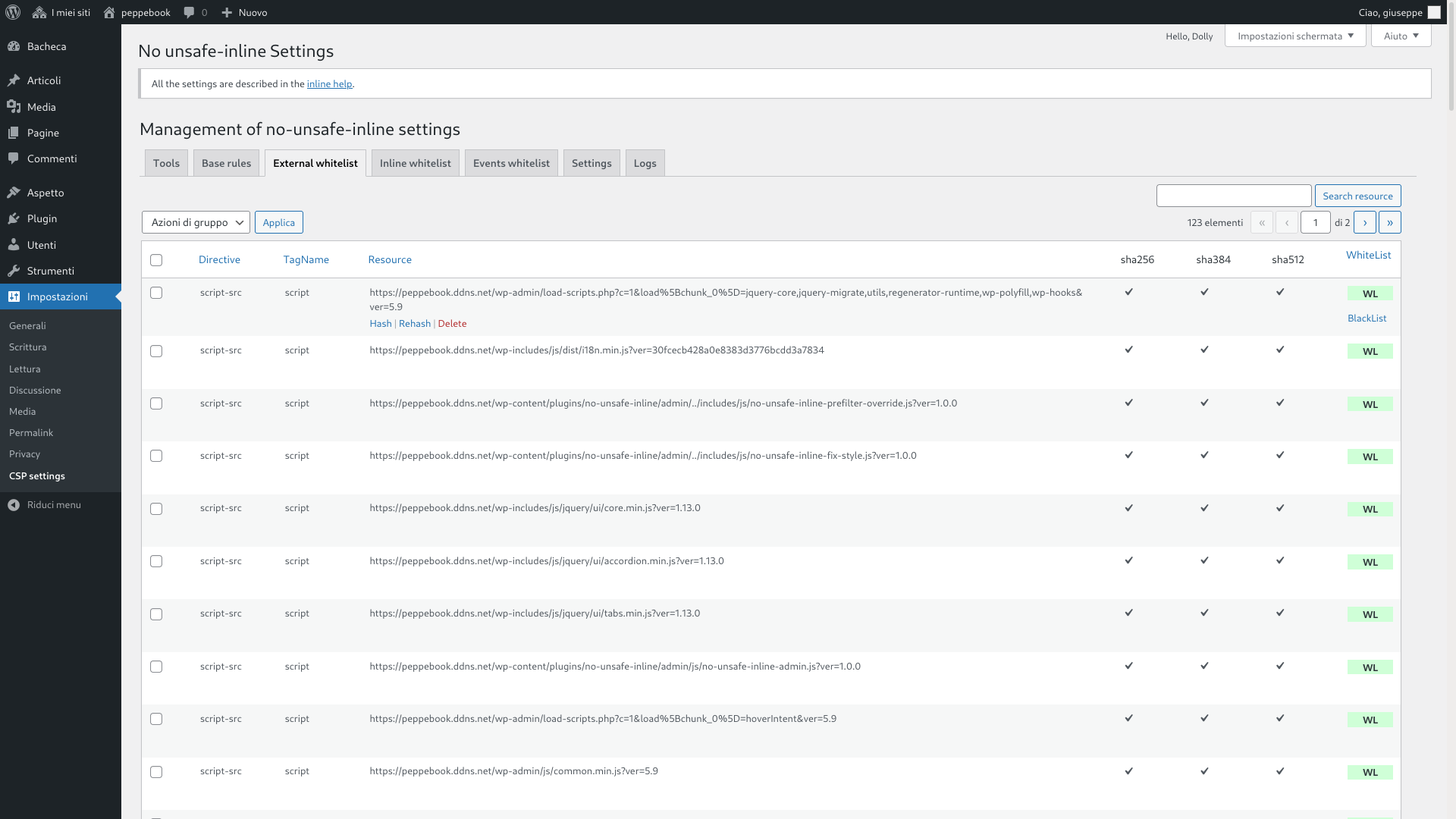
No unsafe-inline Plugin
No unsafe-inline helps you to build a Content Security Policy avoiding to use 'unsafe-inline' and 'unsafe-hashes'.
Content Security Policy (CSP) is a computer security standard introduced to prevent cross-site scripting (XSS), clickjacking and other code injection attacks resulting from execution of malicious content in the trusted web page context.
Cross-site scripting (XSS) is a type of security vulnerability that can be found in some web applications.
XSS attacks enable attackers to inject client-side scripts into web pages viewed by other users.
A cross-site scripting vulnerability may be used by attackers to bypass access controls like the same-origin policy.
Looking at National Vulnerability Database run by US NIST, more than 900 (March 2024) vulnerabilities are reported as XSS for WordPress’ plugins and themes.
Keeping your site up-to-date with the latest versions of plugins and themes is the first line of defense to ensure your site’s security.
The second thing to do, is to deploy a strict Content Security Policy.
The main problem
The main problem with Content Security Policies implemented in the real world is that they are too weak to really protect your site and that many of them can be trivially bypassed by an attacker.
The proposed solution
Google researchers recommend, instead of whole host whitelisting, to activate individual scripts via a CSP nonces approach.
In addition, in order to faciliatate the adoption of nonce-based CSP, they proposed the ’strict-dynamic’ keyword.
The problem(s) with CSP in WordPress
Manual creation of a policy
Usually, a WordPress project is a mix of code written by different authors who contributed to the Core and or wrote plugins and themes.
If it is possible to whitelist every external script loaded from a<script src="">, the real truth is that in a WordPress project you can have dozens of those scripts included with your plugins and calculate a cryptographic hash for each of them to be included in your CSP header can be a frustrating job. However, there are many browser extensions and WordPress’ plugins that can help you in this job.Inline scripts
WordPress core, and plugins use inline scripts. For these scripts, you can compute hashes to be inserted manually into your policy, only if these scripts do not change at any page load. Unfortunately, this is not very common as it is frequent to include variable values calculated server side in inline scripts. And it means that your inline scripts change too frequently to manually add their hashes to your policy.
This commonly happens when scripts are “localized”.WordPress has no API to implement nonces for CSP
Even if it is easy to generate a nonce for each page view, this nonce has to be inserted in every script tag used to embed inline scripts in your page as
<script nonce="rAnd0m"> doWhatever(); </script>and in your script-src directive:
script-src 'nonce-rAnd0m';And, of course, a nonce must be unique for each HTTP response.
Unsafe hashes / Inline styles
Sometimes, HTML elements as images or button uses HTML Event Attributes (onclick, onsubmit…) to let events trigger actions in a browser.
You cannot use hashes or nonces for script included in event attributes and, adopting a strict CSP, requires refactoring those patterns into safer alternatives or to use ‘unsafe-hashes’.
You got a similar problem when inline styles are used in HTML tags:<h1 style="color:blue;text-align:center;">This is a heading</h1> <p style="color:red;">This is a paragraph.</p>CSP Level 2 browsers may be ok with just putting the hash in your style-src directive. However, to allow hashes in the style attribute on inline CSS on browsers that support CSP Level 3, you may get an error like this
Refused to apply inline style because it violates the following Content Security Policy directive: "style-src 'self' 'sha256-nMxMqdZhkHxz5vAuW/PAoLvECzzsmeAxD/BNwG15HuA='". Either the 'unsafe-inline' keyword, a hash ('sha256-nMxMqdZhkHxz5vAuW/PAoLvECzzsmeAxD/BNwG15HuA='), or a nonce ('nonce-...') is required to enable inline execution.To allow inline styles you need to use ‘unsafe-hashes’ in your style-src directive (that is, in facts, unsafe).
^
This plugin approach
This plugin affords those problems in this way:
- During a capture phase, it detects the scripts, styles and other embedded content present in the pages of your site and stores them in the database.
- Then you have to whitelist these contents from plugin admin.
- The plugin uses machine learning to cluster inline scripts trying to aggregate scripts generated by the same server side (PHP) code. So, you can authorize one script example to authorize all scripts that the classifier predicts to label as whitelisted clusters.
- You can choose to use hashes to authorize external scripts (and the plugin will allow you to include Subresource Integrity in your
<script>and<link>) - You can use hashes or nonces to authorize inline scripts.
- You can ask the plugin to refactor your page to not use event attributes (converted in a inline script) and inline styles (converted in an internal CSS).
- You can set one or more violations’ report endpoints.
The plugin supports multisite installations and has (too) many options documented in inline help.
Creating a Content Security Policy
After plugin activation, go to Settings menu and search for CSP Settings submenu.
The steps you are supposed to do are the following.
- From the Tools tab, activate the capture of the tags and use your site by visiting all the pages or making them visits from your users for a long time long period based on the use of your site (hours or days).
- From the Tools tab perform the data clustering in the database (it can use many server resources).
- Go to the Base rules tab and include in the CSP directives the desired values (help you with the table at the bottom of the page).
- Go to to external scripts tab, inline scripts tab and scripts invoked by event handlers tab and authorize the execution of all the legitimate scripts present on the pages of your site.
- Leaving the tag capture active, activate the policy test (at this stage the plugin will generate some violations of the temporary policy used to record additional values to be included in the directives of your “content security policy”).
- After visiting again your site pages, disable the capture of the tags and repeat the previous steps 2, 3 and 4.
- Enable site protection.
N.B. When you update plugins or themes, if something doesn’t work properly on your site pages, temporarily deactivate the protection and repeat steps 1 to 7.
Code and libraries
This version of the plugin uses:
* ivopetkov/HTML5DOMDocument to parse HTML;
* RubixML for machine learning from version 1.1.0 – PHP-ML was used in versions 1.0.x;
* opctim/php-nilsimsa to calculate and compare Nilsimsa digests.
The log functions have been taken from
* perfectyorg/perfecty-push-wp, something you should really try if you want to implement web Push notifications in your site.
The complete list of dependencies used in this plugin can be seen in dependency graph on GitHub.
Contributions, Issues, Bugs
Plugin code is hosted on a public repository on GitHub.
Reach me over there to help and suggest.
Installation
Automatic installation
- Plugin admin panel and
add newoption. - Search in the text box
No unsafe-inline. - Position yourself on the description of this plugin and select install.
- Activate the plugin from the WordPress admin panel.
Manual installation of ZIP file
- Download the .ZIP file from this screen.
- Select add plugin option from the admin panel.
- Select
uploadoption at the top and select the file you downloaded. - Confirm installation and activation of the plugin from the administration panel.
Manual FTP installation
- Download the .ZIP file from this screen and unzip it.
- FTP access to your folder on the web server.
- Copy the whole
no-unsafe-inlinefolder to the/wp-content/plugins/directory - Activate the plugin from the WordPress admin panel.
Screenshots
FAQ
This is not a click and go tool, but you can follow the instructions and implement a strict CSP.
No.
During capturing phase this plugin needs to write many data to database, so your site can slow down.
When the plugin enforces the CSP, it uses a mu-plugin to capture the output of the WordPress process, manipulate it and then send to browser.
I don’t have any measure of inherent overhead.
Not in my knowledge.
No. But I do my best to offer free support on wordpress.org support forum in my spare time.
No.
Changelog
1.2.1
Bug fixes
1.2.0
- Added persistence and online (partial) training to Knn classifiers
- Added checks on startup for PHP build options
- Fixed error thrown when malfromed URL are parsed while capture is enabled
- Modified classificators tests
- Improvements at the UI
1.1.5
- Update external scripts table on plugin/theme/core update
- Added a check for PHP extension requirements on startup
- Added a polyfill to be used when PHP is built with –disable-mbregex
1.1.4
- Fix src_attrib field size for long URLs
- Remove spatie\async from codebase and use fibers to execute long processes after page output
- Fix summary report
1.1.3
- Reduce the number of capture occurences
- (dev) adding support for SCRIPT_DEBUG
- Update composer and npm dependencies
- Fix admin js for jquery deprecations
- Adding some cookie scripts to the list of scripts that do not support SRI
1.1.2
- Removed the use of ‘hash-value’ to allow external styles – not supported by CSP
- Removed the use of ‘hash-value’ to allow external images – not supported by CSP
- Added code to prune legacy external assets when pruning db
- Forced synchronous code execution
1.1.1
- Bug fixes
- Improved compatibility with PHP 8.2
1.1.0
- Moving to RubixML lib for machine-learning.
- Fixed bug in capturing tags.
- Fixed bug in pruning clusters.
- Added a mutation observer for inline styles transfered to the internal css.
1.0.2
- Fix results count error and default order in list_tables.
- Avoid sending CSP on not HTML or XML Document responses.
- Include page capture in asyncronous execution.
- Removing double conversion of nilsimsa, while clustering.
1.0.1
- Lowered priority for action and filter called on shutdown hook.
- Moved default value for inline_scripts_mode option to ‘nonce’.
- Fixed server error when csp header is too long.
- Added setting to define HTTP Response Header Limit.
- Added a waiting spinner on tools’ page of admin interface.
1.0.0
- First plugin submission to WordPress.org




